What was the Cambrian period?
The Cambrian period, which occurred approximately 541 to 485 million years ago, is the first period of the Paleozoic era. It is known for the Cambrian explosion, a period of rapid diversification of multicellular life forms, including the appearance of many major groups of animals.
Key Events and Characteristics of the Cambrian Period:
- Cambrian Explosion: During this time, there was a rapid diversification of life forms, leading to the emergence of many major animal groups, including arthropods, mollusks, and chordates.
- Development of Hard Parts: Many organisms began to develop hard parts such as shells and exoskeletons, which contributed to the preservation of their fossils.
- Formation of Supercontinents: The Cambrian period saw the formation of the supercontinent Gondwana, which later broke apart to form the continents we know today.
- Paleogeography: The distribution of land and seas was significantly different from today, with shallow seas covering many parts of the continents.
Study Guide Questions:
- What is the Cambrian explosion and why is it significant?
The Cambrian explosion refers to the relatively rapid diversification of multicellular life forms during the Cambrian period. It is significant because it marks the appearance of many major groups of animals, leading to the establishment of complex ecosystems. - How did the development of hard parts contribute to the Cambrian fossil record?
The development of hard parts such as shells and exoskeletons contributed to the preservation of organisms as fossils, providing valuable evidence of the diversity and morphology of Cambrian life forms. - Describe the paleogeography of the Cambrian period and its significance.
During the Cambrian period, shallow seas covered many parts of the continents, leading to the deposition of sedimentary rocks that preserve a rich record of Cambrian life. The paleogeography also influenced the distribution of marine organisms and the evolution of marine ecosystems. - What were some of the major animal groups that emerged during the Cambrian period?
During the Cambrian period, major animal groups such as arthropods (including trilobites), mollusks, and chordates (early ancestors of vertebrates) emerged and diversified, laying the foundation for future evolutionary developments. - How did the Cambrian period set the stage for future evolution and the colonization of land?
The Cambrian period set the stage for future evolution by establishing the basic body plans and ecological relationships of many animal groups. The development of hard parts and the diversification of marine life also set the stage for the eventual colonization of land by plants and animals.
[Cambrian] Related Worksheets and Study Guides:
.◂Science Worksheets and Study Guides Sixth Grade. Mollusks, Arthropods and Echinoderms
Study Guide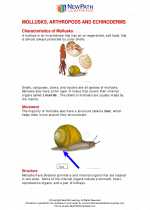 Mollusks, Arthropods and Echinoderms
Mollusks, Arthropods and Echinoderms  Activity Lesson
Activity Lesson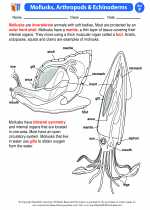 Mollusks, Arthropods & Echinoderms
Mollusks, Arthropods & Echinoderms  Worksheet/Answer key
Worksheet/Answer key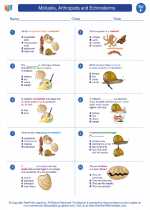 Mollusks, Arthropods and Echinoderms
Mollusks, Arthropods and Echinoderms  Worksheet/Answer key
Worksheet/Answer key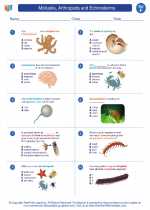 Mollusks, Arthropods and Echinoderms
Mollusks, Arthropods and Echinoderms  Worksheet/Answer key
Worksheet/Answer key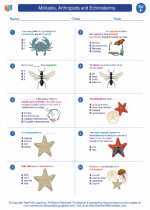 Mollusks, Arthropods and Echinoderms
Mollusks, Arthropods and Echinoderms  Worksheet/Answer key
Worksheet/Answer key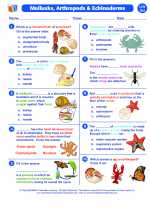 Mollusks, Arthropods and Echinoderms
Mollusks, Arthropods and Echinoderms  Vocabulary/Answer key
Vocabulary/Answer key Mollusks, Arthropods and Echinoderms
Mollusks, Arthropods and Echinoderms  Vocabulary/Answer key
Vocabulary/Answer key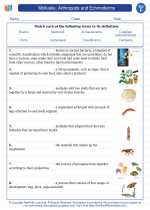 Mollusks, Arthropods and Echinoderms
Mollusks, Arthropods and Echinoderms  Vocabulary/Answer key
Vocabulary/Answer key Mollusks, Arthropods and Echinoderms
Mollusks, Arthropods and Echinoderms  Vocabulary/Answer key
Vocabulary/Answer key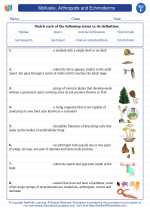 Mollusks, Arthropods and Echinoderms
Mollusks, Arthropods and Echinoderms  Vocabulary/Answer key
Vocabulary/Answer key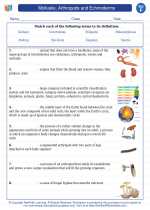 Mollusks, Arthropods and Echinoderms
Mollusks, Arthropods and Echinoderms  Vocabulary/Answer key
Vocabulary/Answer key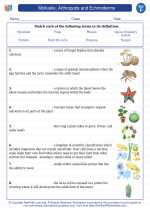 Mollusks, Arthropods and Echinoderms
Mollusks, Arthropods and Echinoderms  Vocabulary/Answer key
Vocabulary/Answer key Mollusks, Arthropods and Echinoderms
Mollusks, Arthropods and Echinoderms 

 Activity Lesson
Activity Lesson
 Worksheet/Answer key
Worksheet/Answer key
 Worksheet/Answer key
Worksheet/Answer key
 Worksheet/Answer key
Worksheet/Answer key
 Worksheet/Answer key
Worksheet/Answer key
 Vocabulary/Answer key
Vocabulary/Answer key
 Vocabulary/Answer key
Vocabulary/Answer key
 Vocabulary/Answer key
Vocabulary/Answer key
 Vocabulary/Answer key
Vocabulary/Answer key
 Vocabulary/Answer key
Vocabulary/Answer key
 Vocabulary/Answer key
Vocabulary/Answer key
 Vocabulary/Answer key
Vocabulary/Answer key

The resources above cover the following skills:
LIFE SCIENCE
From Molecules to Organisms: Structures and Processes